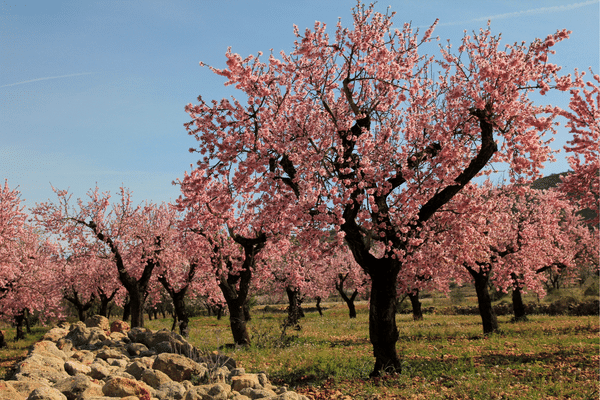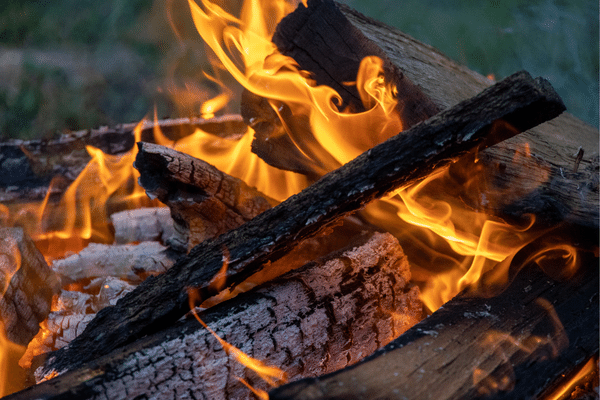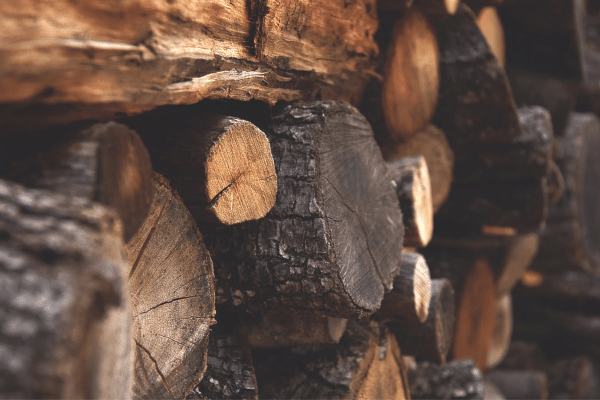- Home
- Types Of Firewood
- Is Almond Good Firewood
Is Almond Good Firewood?
This post may contain affiliate links so I earn a commission.
Is almond good firewood or are there better options you can choose?
Almond is an interesting tree, since it has distinct properties that make it feasible as a source of firewood.
Its physical properties, particularly when compared to other types of wood, can provide distinct advantages for individuals who want to heat their home with firewood, or enjoy a delicious smoke flavored meal.
Almond has been known to be quick to season - far quicker than many other varieties - and easier to split when dried.
Though many hardwoods are strong in comparison to softer woods like pine, almond firewood offers relatively dense and heavy firewood with little splitting effort required.

On top of these qualities due to its nature,
almond produces particularly good coals and gives off a fragrant scent
when burning.
If available in your region, it just might offer the perfect solution for your needs for an effective yet pleasant firewood experience!
Let's take a closer look.
Facts About Almond Trees
Almond is a native to the Middle East, but has also found success in areas with Mediterranean climates like Central California.
It can also be found in parts of Arizona, Texas and Georgia; however, its susceptibility to fungal disease increases further east.
Generally, almond trees will grow up to 30 feet tall and if given enough space, have a wide crown that's nearly as large as its height.
Almond wood has numerous uses, one example being fine woodworking.
But it is most noticeable for providing highly desired firewood for burning and for the edible nut that it produces.
No matter how it's used, this tree species surely adds beauty and utility to any environment.
Is Almond A Hardwood Or Softwood?
Almond is a bit of an enigma when it comes to its classification as hardwood or softwood.
It shares the deciduous trait with all hardwoods, meaning its leaves change color during autumn and are shed in winter.

On the other hand, the wood itself is lighter
than most hardwoods and comparable to some softwoods such as pine or fir.
However, although it may not have the density of true hardwoods like oak or mahogany, almond wood still has a hardness that makes it suitable for use in furniture-making and other woodworking projects.
So while considered "lighter" it is strong enough to be classified as a hardwood.
What Can You Do With Almond Wood?
Almond wood is one of the top five kinds of wood to heat with, not only because it puts out a remarkable 32.9 million BTUs of heat per cord, but also because it needs roughly a year to season and achieve its best output.
Woodworkers turn to almond because of its use in fine woodworking such as turnings and cabinetry, although board ends should be sealed as it is prone to checking or splitting from the humidity changes.
Almond is also an excellent choice for campfires; it has minimal resin resulting in minimal sparking, little smoke and a pleasant smell while burning.

The nutty flavor of almond makes it a great
choice for grilling and smoking meat, seafood, or vegetables.
Although it's accepted as a fruit and nut tree, it has distinct characteristics similar to cherry, apple and plum trees in regards to its reddish color as well as its woodworking qualities which are similar to oak.
It's known for being especially hard yet still displaying a beautiful grain pattern with lovely colors, making this an ideal choice for projects such as furniture that requires strong woods that also look aesthetically pleasing.
Aside from its appeal in the field of woodworking, almond trees are perhaps most prized for their produce; they yield a delicious nut with numerous health benefits.
Is Almond Good Firewood To Split?
So, we know that almond creates amazing heat for its overall weight, but is almond good firewood to split?
I'd say it's average.
Almond is a popular firewood and splitting it with a splitting axe or maul is doable, though a mechanical wood splitter makes the job much easier.

Seasoning almond firewood doesn't require a lengthy amount of time; most
say 6 months will bring it to its optimum moisture content, but I think a year is more realistic.
When green, almond firewood has about 55% moisture content but for the hottest and longest-lasting fire, only 15-20% moisture is necessary.
Best Way To Store Almond Firewood
Properly stored almond firewood is essential for a good fire.
For best results, it should be stacked in rows that are exposed to sunlight and spaced out with adequate air flow between each row.
Stacked wood should not be completely covered as this will make it difficult for the moisture to escape and can hinder the drying process.
Just cover the top 1/3 portion of the firewood stack.
It is highly recommended to use old metal roofing or tarps to keep out rainwater when covering the stacks.
Additionally, the wood should be kept off the ground, which can be accomplished in various ways, such as pallets or any other kind of lumber that you may have lying around.
If you need a quick and easy way to build a firewood rack, check out this simple cinder block firewood rack that only takes a few minutes to create.
Is Almond Good Firewood To Burn - Wood Stoves And Fireplaces
Almond is an excellent choice for burning in fireplaces and wood stoves because of its high BTU (British Thermal Unit) output.

It has a longer burn time than other types of firewood and produces low
amounts of ash.
The wood, which is comparable to oak, is denser than many other hardwoods but this also makes it harder to source as it isn't as widely available.
For maximum efficiency, many people mix almond with a lesser quality, more abundant wood - enough logs can be burned on top of existing coals to provide hours of warmth.
Does Almond Firewood Produce Sparks And Creosote?
When burning almond firewood, it can be a reassuring thought that there isn't excessive sparking or creosote to worry about.
Although the wood does burn intensely hot, it is composed of low resin and sap content, meaning there should be little sparking or the potential for a buildup of creosote if the wood is dry.
This makes almond a great choice for those who don't want to take too many risks when burning firewood in their home.
Is Almond Good Firewood - Overall
There are many benefits that come with using almond as firewood.
In fact, it is one of the best woods to use for this purpose.
Almond burns hot and long, produces little smoke, and leaves behind very little ash.
It is also a great source of heat energy when compared to other types of wood.
If you are looking for an efficient and effective way to keep your home warm this winter, consider burning almond in your fireplace or wood stove!


